FOR ADVERTISING
CONTACT:
Prem Dutt: Email
Call Prem: (916) 743-8316
Seema Gupta: Email
Call Prem: (408) 745-9663
|
|
EDITORIAL:
Ayurveda in America
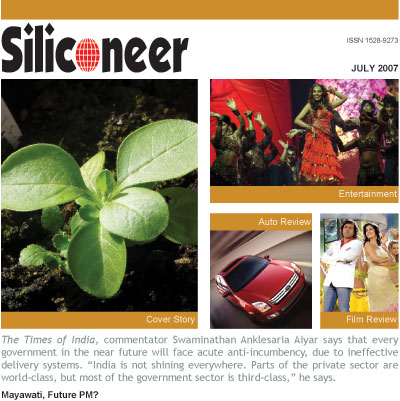 It must be one of the mysteries that amid all the hoopla in this country regarding alternative medicine, Ayurveda, the ancient school of medicine from India, remains behind in official acceptance in the U.S. compared to other alternative schools of medicine like, say, Chinese acupuncture. It must be one of the mysteries that amid all the hoopla in this country regarding alternative medicine, Ayurveda, the ancient school of medicine from India, remains behind in official acceptance in the U.S. compared to other alternative schools of medicine like, say, Chinese acupuncture.
One of the reasons is demographics and history. The Chinese have been here for a longer period and in greater numbers. Indians came here later, and the big push happened as late as the 1960s.
To be sure, there was a lot to be admired when it comes to Western medicine. However, today there is a growing realization that even Western medicine has its limitations, and here Ayurveda can make a real contribution in some of these areas.
Ironically, it is the relative lack of interest of expatriate Indians in Ayurveda that has doomed any mainstream acceptance of the benefits of Ayurveda in this country. Maryland-based urologist Dr. Navin Shah, a co-founder of the American Association of Physicians from India, has taken a commendably astute move to establish the credentials of Ayurveda in this country.
He has rightly figured out that the best way to introduce Ayurveda is to take a two-fold approach: Introduce it in the mainstream medical curriculum of this country, and do it by using scientifically verifiable evidence of the benefits of Ayurveda.
What’s particularly creditable is that he hasn’t just talked the talk, but he has been walking the walk. He has been indefatigable in following up with the Indian government, and an Ayurveda expert who is also trained in Western medicine was on a tour where he gave lectures in several medical schools and met officials at the National Institutes of Health.
Dr. Shah has written about it in this month’s cover story.
Pakistan has the misfortune of being in the eye of conflict and turbulence for decades now, what with the Afghan crisis and murder and mayhem in Karachi where ethnic and sectarian conflict has crippled that port city. Yet that’s never the whole story. Like any nation, it has its share of civic minded citizens who have lofty dreams about where they want to take their country and society, but their stories get lost in the somewhat dubious bias that journalism has for bad news, disasters and sensationalism.
In the Bay Area, Pakistanis are also very much part of the South Asian success story, and it has its share of highly educated and successful entrepreneurs and professionals. There is no better exemplar of this than OPEN — The Organization of Pakistani Entrepreneurs of North America. It’s a sort of a Pakistani version of The Indus Entrepreneurs, the rightly-celebrated organization of predominantly Indian high tech honchos. (It’s great to know that the two organizations are not mutually exclusive; Pakistani high tech entrepreneurs are an important part of TiE itself, which has chapters in Pakistan).
OPEN’s Silicon Valley chapter recently held its fourth annual gathering in Palo Alto and it highlighted not only the tremendous strides some Pakistani Americans have made, but also a civic-spirited commitment to society that is an essential ingredient for a well-rounded prosperous community.
So in addition to the pep talks of Silicon Valley hot shots and, say, a panelist like Raghib Hussain, who co-founded a company which recently had a huge IPO on NASDAQ, you also had the likes Khalid “Paniwaala” who is trying to promote water cleanliness in the slums of Karachi.
We carry a detailed report on the conference in this month’s issue.
It’s perhaps no exaggeration to say that the enactment — and more importantly, the implementation — of the Right to Information Act is arguably a landmark achievement of people’s empowerment in India since independence.
As we celebrate the achievement of people to hold government accountable — and news keeps continuously pouring in how ordinary people from all walks of life are using their newfound power to make government officials accountable.
The movement for the RTI Act, which is very similar to the Freedom of Information Act in the U.S., has underscored the point that continued, diligent civic engagement is vital for the health of a democracy.
India’s superb record in electoral democracy can be somewhat illusory; it is easy to forget that while the nation conducts elections with a degree of fairness and transparency that does the nation proud, what happens in the interregnum between polls is less salubrious.
The RTI is a profoundly important step in the right direction to rectify this deficiency, and now Indian Americans can (and should!) get engaged too, because the Indian embassy is under the purview of the act, and any Non-resident Indian can file a request.
Read more about it in a feature article in this month’s issue.
Do drop us a line with ideas and comments about how we can make Siliconeer better serve you.
|TOP|
COVER STORY:
Ayurveda in America: The First Steps
India’s 5,000-year-old system of medicine, Ayurveda, can bring remarkable benefits to patients suffering from chronic ailments. Now the first steps are being taken to introduce Ayurveda into mainstream U.S. medical education, writes Navin Shah, MD, who is spearheading efforts in this direction.
 There are a host of conditions — ranging from chronic illnesses like diabetes and hypertension to iatrogenic diseases and mental illnesses — where Western medicine is less than satisfactory. This is where Ayurveda, India’s ancient system of medicine, could play a useful role, provided its claims can be verified scientifically. There are a host of conditions — ranging from chronic illnesses like diabetes and hypertension to iatrogenic diseases and mental illnesses — where Western medicine is less than satisfactory. This is where Ayurveda, India’s ancient system of medicine, could play a useful role, provided its claims can be verified scientifically.
After some voluntary efforts, beginning steps have been taken to introduce American physicians and health policymakers to this ancient Indian health system.
Ayurveda, (Sanskrit for “knowledge of life”), is being practiced in India for over 5,000 years. Ayurveda not only provides treatment of disease but also guides to prevent illness, helps to maintain wellness, and creates harmony of the mind, soul and body. With its unique concept and practice of yoga and meditation, this ancient system helps to maintain proper mental and physical health. By virtue of identification of individuals’ biologic constitution Ayurveda provides personalized preventative and therapeutic treatments. Ayurveda stresses the importance of foods and fluids intake in health and diseased states.
Modern Western medicine as practiced in the U.S. has its limitations causing some iatrogenic diseases and treatment-related complications in the patients. In order to improve patient care the U.S. medical community, some eight years ago, explored the assistance of other traditional local remedies especially of India, China, Africa and other ancient lands. Some of these medicines and medical practices are being incorporated under Complementary Alternative Medicine to improve the treatment outcomes. Of 125 U.S. medical schools, about 80 schools have some form of CAM teaching.
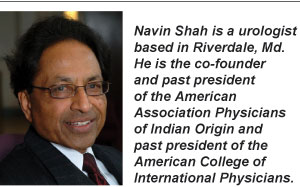 Five years ago, then Prime Minister Atal Behari Vajpayee asked me to help promote Ayurveda in the U.S. I suggested two avenues to introduce Ayurveda in the mainstream U.S. medicine: Five years ago, then Prime Minister Atal Behari Vajpayee asked me to help promote Ayurveda in the U.S. I suggested two avenues to introduce Ayurveda in the mainstream U.S. medicine:
- A. Teaching a short course on Ayurveda by eminent Indian Ayurveda professors in a few willing U.S. medical schools for medical students, faculty members and practicing physicians at no cost.
- B. Conduct joint Indo-U.S. research in Ayurveda with funding from the National Institutes of Health.
In the following years, I visited New Delhi several times and had meetings with the prime minister and the secretary of health in pursuit of this project.
In January last year, I met and discussed the project with Prime Minister Manmohan Singh, Principal Secretary to the Prime Minister T.K.A. Nair and joint secretary Shiv Basant. They all supported the project.
In December last year, during our meeting, Shiv Basant agreed to depute two eminent Ayurveda professors to teach a short course of 12 hours on Ayurveda and meet with various medical schools’ faculties for joint research projects in Ayurveda. In April this year I visited New Delhi and met with the prime minister.
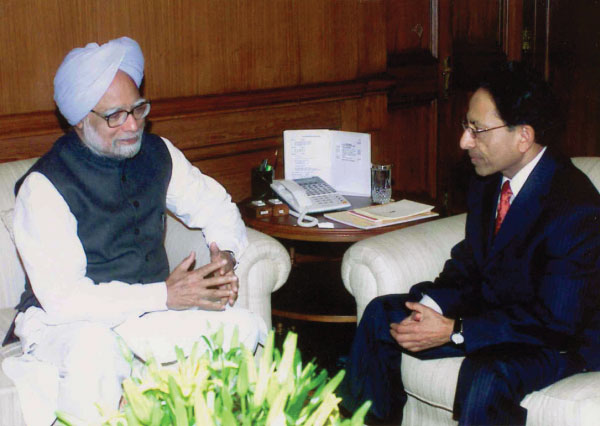
(Above): Dr. Navin Shah (r) seen here at a meeting with Prime Minister Manmohan Singh
in New Delhi.
Dr. H.S. Palep , professor of Ayurveda and an authority on Ayurveda, was selected to visit the U.S. Palep visited the U.S. from May 1 to June 3. With the help of multiple medical school faculty members, science counselor of embassy of India Dr. K.K. Dwivedi, AAPI past president Dr. Balasubramaniam, AAPI president Dr. Hemant Patel and treasurer Dr. A. Singhvi, I arranged a five-week program.
AAPI provided for Dr. Palep’s local hospitality expenses. On May 3, Dr. Palep and I visited with Dr. Jack Killen, director of the National Center for Complementary and Alternative Medicine/ NIH for joint Indo-U.S. research in Ayurveda. Dr. Killen was very supportive of joint research projects and invited proposals. Dr. Palep alluded to some of the work he is involved in and also suggested some important areas of research.
In the following five weeks during his visits with various medical schools faculties (including Harvard, Hopkins, Uniformed Services, Georgetown, George Washington, Howard and university medical schools in New Jersey) Dr. Palep had multiple discussions on various joint research proposals.
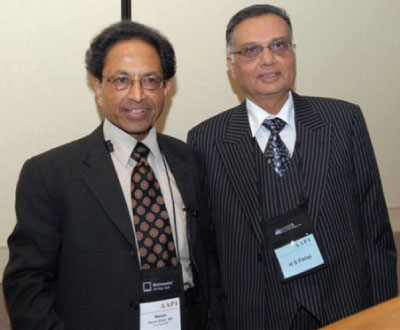 Dr. Palep (seen here on the right) and I will follow it up with respective faculty members for possible NIH submission. Dr. Palep conducted four 12-hour courses (Washington D.C., Baltimore, Philadelphia, New Jersey) and made several presentations to various medical schools. He delivered the course with great clarity and covered important aspects of Ayurveda including; Dr. Palep (seen here on the right) and I will follow it up with respective faculty members for possible NIH submission. Dr. Palep conducted four 12-hour courses (Washington D.C., Baltimore, Philadelphia, New Jersey) and made several presentations to various medical schools. He delivered the course with great clarity and covered important aspects of Ayurveda including;
A. Basic concepts in Ayurveda; B. Ayurveda anatomy and physiology; C. Process of disease formation; D. Ayurveda pharmacology; E. Ayurveda clinical examination: pulse reading and individual constitution identification; F. Diagnosis and treatment — both preventative and therapeutic; G. Detoxifying and rejuvenation therapies — Panchkarma Yoga and meditation; H. Evidenced-based Ayurveda — both in Ayurveda and in integration with allopathy
Palep is uniquely qualified to teach the U.S. medicos as he has graduated from both Ayurveda and allopathy medical colleges. His mastery over the subjects as well as his communication skills helped attendees to understand the 5,000-year-old ancient Indian medical system in the modern medical language. Palep May 19 delivered a three-hour course on Ayurveda to about 50 physicians attending the AAPI annual convention in Philadelphia.
At the Harvard Medical School Palep met with various important officials and faculty members for both Ayurveda education and joint research in Ayurveda-including Dr. Sanjiv Chopra, dean of Continuing Medical Education; Dr. Om Ganda, professor of medicine; Dr. Robert Saper (CAM and integrative medicine); Dr. Russell Phillips ( Prof. chief of general medicine ),and Dr. Vikas Sukhatme (chief of nephrology).
On June 18 I met with six senior officials of the American Association of Medical Colleges and presented a proposal for introducing a short course on Ayurveda under Complementary Alternative Medicine in the U.S. medical school curriculum. I presented the details of the Ayurveda course and acquainted them with positive response to the recent courses conducted by Palep. In addition I discussed some of the important abstracts provided by Dr. G.S. Lavekar, proving significant role of Ayurveda in different disease managements as well as in some animal experiments. I stressed the evidence-based benefits of yoga and meditation in different diseases. Panchkarma treatments and its possible benefits were also cited.
Our dis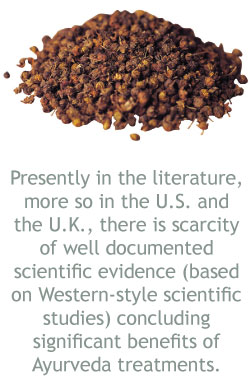 cussion resulted in the following conclusions: cussion resulted in the following conclusions:
- Presently in the literature, more so in the U.S. and the U.K., there is a scarcity of well-documented scientific evidence (based on Western-style scientific studies) concluding significant benefits of Ayurveda treatments.
- Due to paucity of proven literature, U.S. medical school faculty members have not shown much interest in the teaching of Ayurveda
- Introduction of Ayurveda in the U.S. can best be done:
- A. By introducing disease management in certain diseases where it has a proven track record (e.g. diabetes, heart diseases, hypertension, osteoarthritis, colitis, depression, etc.). Chronic diseases will be more helpful due to heavy patient load in the U.S.
- B. By introducing drugs herbs with specific benefits
- C. By providing practical training in yoga and meditation
Once we have proven benefits in outcomes by utilizing Ayurveda in preventative and therapeutic areas, then regular Ayurveda course be introduced.
I have suggested the following to Indian health officials:
- Search all the Indian as well as Western literature (Medline) for solid scientific evidence on beneficial effects of Ayurveda and present a report. In case of multiple studies, review articles need to be prepared. Important papers and findings should be published in U.S. journals to acquaint the U.S. medicos.
- Well planned and organized annual teaching visits of Ayurveda professors in willing medical schools and their teaching hospitals both for Ayurveda teaching (mainly evidence-based disease treatment, yoga and meditation) and joint Ayurveda research with NIH funding.
- The Indian government should invite a delegation of a few U.S. medical school CAM faculty members for discussions and visits to various Ayurveda colleges, hospitals, manufacturing and research facilities in India, so as to acquaint them of Ayurveda in detail.
We must continue to pursue what we have initiated for a long-term goal of introduction of Ayurveda in the mainstream U.S. medicine. I am optimistic of its success as U.S. patients and population do utilize herbal medicines/products and services on their own by spending $40 billion annually and the U.S. mainstream medicine has accepted CAM in patient care based on the scientific evidence.
Finally my plea to medical school faculty members, especially of Indian origin: Provide active assistance in this vital project which I believe will help both our profession and our patients.
|TOP|
BUSINESS:
Rational Exuberance: OPEN Conference
The Organization of Pakistani Entrepreneurs of North America Silicon Valley chapter’s conference in Palo Alto had three hundred people in attendance who took advantage of the experience and success of those that have already made their mark in the world of business, writes Ras Hafiz Siddiqui.
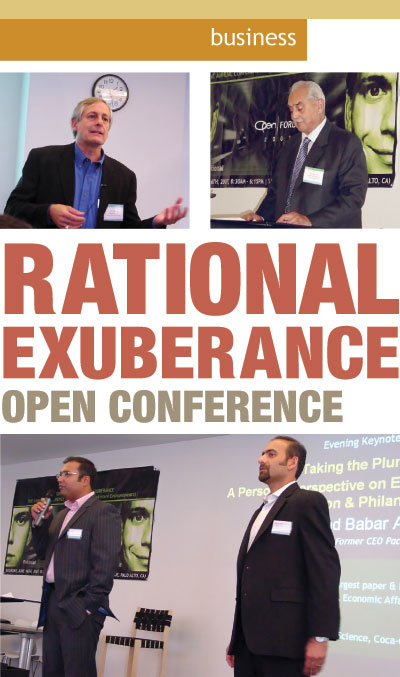 (Top, left): Afternoon keynote speaker Bill Reichert, general partner at Garage Ventures. (Top, left): Afternoon keynote speaker Bill Reichert, general partner at Garage Ventures.
(Top, right): Keynote speaker Syed Babar Ali of Lahore Institute of Management Sciences (LUMS).
(Below): OPEN-SV president Umair Khan (l) and Dilawar Syed welcoming delegates at the start of OPEN conference at SAP headquarters in Palo Alto, Calif., June 16. [All photos by Ras Hafiz Siddiqui]
The Organization of Pakistani Entrepreneurs of North America Silicon Valley chapter (www.opensiliconvalley.com) held its fourth annual gathering at SAP headquarters in Palo Alto, Calif., June 16, by testing the “rational exuberance” of both the valley hi-tech industry and the spirit of enterprise within the Pakistani-American community today. This full-day affair incorporated three keynote speeches, four panels and workshops each, during which approximately three hundred people in attendance took advantage of the experience and success of those that have already made their mark in the world of business.
The event started off with a registration period and a light breakfast followed by its formal opening by OPEN-SV president Umair Khan. Umair welcomed everyone and briefly touched on the accomplishments of the organization in the short time that it has been around, including its developing relationships with top notch universities such as MIT and UC Berkeley.
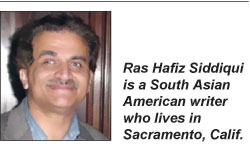 Dilawar Syed next introduced us to the day’s schedule and their logistical elements of this forum. He started by introducing Professor Tom Byers, head of the tech ventures program at Stanford University. Tom started off on the question “Are entrepreneurs born or made?” and took a poll on that (almost a split vote). He presented a short introduction to the Stanford Technology Ventures Program. “I am trying to think about now and the future,” he said while addressing the strategic aspects of technology funding today. He said that U.S. venture capital is still watching IT and photonics, nanotechnology, environment and energy prospects today. Armed with statistics on capital availability Tom presented a Jeff Hawkins video on what it takes to be an entrepreneur. “You have to know a little bit about everything,” it said, and nothing could be truer in the world of business startups today. In other words, entrepreneurship is a management style that involves pursuing opportunity without regard to resources currently controlled. Byers added that only a few universities taught entrepreneurship in 1970 and today hundreds of them are doing so. He shared his thoughts on what makes a great business opportunity, a good business plan and necessary wisdom: “Success comes after much toil,” he said. Dilawar Syed next introduced us to the day’s schedule and their logistical elements of this forum. He started by introducing Professor Tom Byers, head of the tech ventures program at Stanford University. Tom started off on the question “Are entrepreneurs born or made?” and took a poll on that (almost a split vote). He presented a short introduction to the Stanford Technology Ventures Program. “I am trying to think about now and the future,” he said while addressing the strategic aspects of technology funding today. He said that U.S. venture capital is still watching IT and photonics, nanotechnology, environment and energy prospects today. Armed with statistics on capital availability Tom presented a Jeff Hawkins video on what it takes to be an entrepreneur. “You have to know a little bit about everything,” it said, and nothing could be truer in the world of business startups today. In other words, entrepreneurship is a management style that involves pursuing opportunity without regard to resources currently controlled. Byers added that only a few universities taught entrepreneurship in 1970 and today hundreds of them are doing so. He shared his thoughts on what makes a great business opportunity, a good business plan and necessary wisdom: “Success comes after much toil,” he said.
Panel 1: “Alternate Paths to Success,” consisted of Monis Rehman (CEO Naseeb Networks), Rehan Jalili (president TSRF), Khalid Saiduddin (founder Saafwater) and Sophia Qureshi (news producer Al Jazeerah). Moderated by Imran Sayeed, this panel incorporated the thoughts of Monis, who introduced “Halal Dating” and employment (Rozee.com) to our community, Rehan, who has been advising American stars on how to keep their bodies fit, Khalid “Paniwaala” who is trying to promote water cleanliness in the slums of Karachi and Sophia whose employer can be considered a “problematic” career choice.
Workshop I which was going on concurrently (making reporting difficult) focused on “Doing Well by Doing Good: For Profit & Not For-Profit Opportunities in Pakistan.” Moderated by Aaref Hilaly, the presenters included Bilal Musharraf (ePlanet Ventures), Ahsan Saleem (Director, The Citizens Foundation) and Yusuf Hussain (MD, PSEB). Bilal spoke on the giving potential of Pakistanis, their philanthropy, and Yusuf spoke on “Pakistan, Destination Next” and on prioritizing human capital. Ahsan Saleem is no stranger to us here since TCF has already established itself in this area (thanks in part to Amjad Noorani).
Panel II: “Profiles in Corporate Success,” included Naseem Amin (SVP Biogen Idec), Kamal Ahmad (MD, Morgan Stanley and Zia Yusuf (EVP SAP). Moderated by Fawad Zakaria, this panel concentrated on breaking glass ceilings and aiming high in corporate America. Naseem said that he never planned to do what he did today, Kamal charted out his journey from America’s rust belt to semiconductors and systems and Zia talked about his experiences at the World Bank where he also met his wife Paru (of the local DIL chapter) and where the two decided to give India-Pakistan friendship a jump-start.
Workshop II held upstairs at the same time (reporting assignments can keep one fit too) dealt specifically with “Fundraising for First Time Entrepreneurs.” Moderated by Waheed Qureshi, speakers Larry Kubal (GP Labrador Ventures), Saeed Amidi (Amidzad Ventures), Tom Fontain (principal Mayfield Fund) and Naeem Zafar (Altair Ventures) reminded everyone of the necessity of doing a thorough study of the market and what need your product fills, and that investors are bright people who cannot be convinced easily. One speaker said that his investment company saw 4000 business plans a year and only invested in 6 or 7. So it was best to be precise and do ones homework before presenting a business plan.
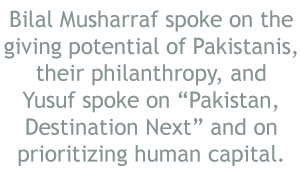 After lunch, which turned out to be a great opportunity for continued networking, Bill Reichert, general partner at Garage Ventures presented the afternoon keynote. Bill touched upon the prevailing wisdom for new ventures namely 1) Come up with a disruptive technology 2) Write a brilliant business plan 3) Raise a pile of money 4) Raise another pile of money etc. 5) Go mainstream by hiring a real CEO. Reichert presented a better “Small is Beautiful” alternative and his version of the “Top Ten NEW Rules for Entrepreneurs and Investors.” Just to mention a couple of them here, Bill said that the fundamental objective from the old rules point of view was to create wealth and from the new rules it was to create value. For the best ways of getting started, the old rule was to have a brilliant entrepreneur start things but the new rule was to build a talented team. The sharing of company vision through a mission statement was old school because the new rule of sharing is through a mantra. He also said that the focus of the old business model was on raising capital, but the new rule focuses on raising revenues. And one important rule that cannot be ignored today is that the “Good old American know how” of yesterday has been replaced by the “Good new GLOBAL know how,” of today. After lunch, which turned out to be a great opportunity for continued networking, Bill Reichert, general partner at Garage Ventures presented the afternoon keynote. Bill touched upon the prevailing wisdom for new ventures namely 1) Come up with a disruptive technology 2) Write a brilliant business plan 3) Raise a pile of money 4) Raise another pile of money etc. 5) Go mainstream by hiring a real CEO. Reichert presented a better “Small is Beautiful” alternative and his version of the “Top Ten NEW Rules for Entrepreneurs and Investors.” Just to mention a couple of them here, Bill said that the fundamental objective from the old rules point of view was to create wealth and from the new rules it was to create value. For the best ways of getting started, the old rule was to have a brilliant entrepreneur start things but the new rule was to build a talented team. The sharing of company vision through a mission statement was old school because the new rule of sharing is through a mantra. He also said that the focus of the old business model was on raising capital, but the new rule focuses on raising revenues. And one important rule that cannot be ignored today is that the “Good old American know how” of yesterday has been replaced by the “Good new GLOBAL know how,” of today.
Panel III: “Opportunities in Global Entrepreneurship” followed on what was to be a very busy afternoon. On the panel, Raghib Hussain (CTO, Cavium Networks), Adnan Lawai (CEO, Folio3), Faraz Hoodbhoy (CEO, Pixsense), Dr. Sana Khan (CEO, TrueMRI) and Salman Akhtar (CEO Techlogix) discussed the merits and possible demerits of going global. This panel was moderated by Umair Khan. Here this writer has to add with pride that Raghib, once a coworker just a few years ago, he is today a co-founder of a company that has just recently had a huge IPO on NASDAQ. All Pakistanis and especially alumni of NED in Karachi should also be proud of him. And one cannot forget Faraz Hoodbhoy here who continues to live up to his last name and is actually hiring Pakistani-Americans to fill key job positions in Pakistan. Salman Akhtar’s company might also be in a similar hiring position.
Workshop III: “Moving to Greener Pastures” dealt with career management. Moderated by Dilawar Syed, the panel consisting of Bari Abdul (SVP McAffee), Mubashar Hameed (SVP & CIO, Fiserv Output Solutions), Hasan Rizvi (VP, Oracle) and Shazia Makhdumi (CEO ColorfulStories) had a chance to share the wisdom that they obtained on their own paths to success. Shazia Makhdumi said that one has to be careful sometimes as to what you ask for because you just might get it (in the career context). Bari Abdul said that “Desis do not do enough networking,” something that many of us are becoming more aware of here today.
Panel IV following the mid-afternoon networking break, certainly turned out to be quite an interesting one. Three startup business plans were presented. Mansoor Khan (DiagnosisOne), Khalid Saiduddin (Founder Saaafwater) and Amra Tareen (CEO Masala Inc.) made their pitch to a group of potential investors on the Panel, namely Ayaz Haque (DFJ ePlanet), Faysal Sohail (CMEA Ventures), Ammar Hanafi (Alloy Ventures) and Bill Reichert (Garage Ventures). Faruq Ahmad moderated this American Idol turned “Entrepreneurial Idol” segment. Each presentation was judged on its own merits. Khalid had the strength of social responsibility behind him as green or environmentally conscious startups are attracting a great deal of investment today. His pilot project in the Lyari area of Karachi, Pakistan is a case in point. Mansoor’s presentation was extremely professionally done. Armed with data it was just a little bit on the dry side. And few could match Amra’s energy of presentation. Out of the four potential investors, three voted for Saafwater and one for Masala. The audience also gave Saafwater their thumbs up, ending the most interactive part of the day.
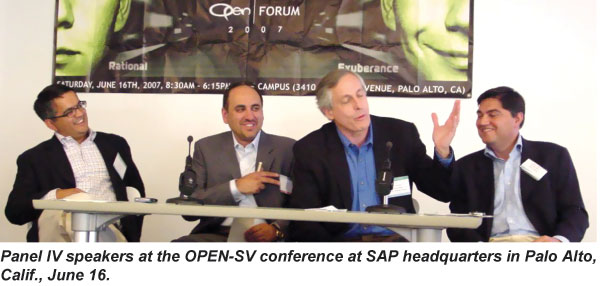
Workshop IV: “Healthy, Wealthy and Wise” concentrated on both our physical and financial health. Presenters Dr. Mobaser Rana, Imran Jaffer, Dr. Adib Ashraf and Dr. Zakia Rahman shared their knowledge of diet, body weight, estate planning and more with us. This workshop was a nice addition to what is usually a technology centric forum.
Being South Asian, our risk is higher,” said Dr. Rana, who still added that paratha avoidance in ones diet is not necessary to lead a healthy life.
After a word of thanks from Umair Khan, the final keynote speaker of the day Syed Babar Ali was introduced to a now packed hall. Speaking on the topic “Taking the Plunge: A Personal Perspective on Entrepreneurship, Education & Philanthropy” the speaker had a remarkable career in all three areas to reflect upon. He founded the Lahore Institute of Management Sciences (LUMS) in 1985 which is the country’s premiere management education institution today. He has also had considerable success in commercial startups in Pakistan including the set up of Packages Limited, Milkpak Limited, Tetra Pak Pakistan Limited and International General Insurance Company Pakistan Limited (to name a few). OPEN Forum attendees were honored to have such a distinguished speaker in their midst.
Syed Babar Ali went through his life experiences in his speech including the establishment of Packages Limited, his involvement in fertilizer promotion, liquid food distribution, his interaction with Z.A. Bhutto, General Zia, and of course the road to the formation of LUMS. He expressed his happiness at the large number of LUMS graduates working in both Pakistan and North America today. “We want to do better,” he said. “We want to establish an Engineering University,” he added. Taking Thomas Friedman’s recent writing in view; he went on to add that we need to find oil in our own backyard in Pakistan (the oil being found in human talent). Sharing his vision of a future school of science and engineering (SSE) attached to LUMS; he said that Pakistan could produce technical talent that the world’s top companies would be happy to employ. He said that initial capital for the project has been raised and the project is scheduled to operate an undergraduate program within five years. Organizations such as OPEN could also help in this effort. “In ten years Lahore will have its own version of Silicon Valley,” said Syed Babar Ali. He said that Pakistanis worldwide are a generous community but they do not invest in building institutional infrastructure in the country. Here we have an opportunity to have a school patterned on Stanford and MIT. “We have to bring the SSE visibility to the Pakistani Diaspora.”
To conclude here, the sponsors of this event, the OPEN Executive Committee and team of volunteers need to be commended for the success of OPEN Forum 2007. It is great to see people step away from politics and learn the ropes of cooperative success using today’s global business model. Cavium Networks is one such example of Pakistani-Indian-American cooperation leading to a NASDAQ winner. Raghib Hussain, a graduate of the Nadirshaw Edulji Dinshaw (NED) Engineering College/University (founded by a member of the Parsi community) in Karachi has assisted in leading his company to its global presence today. Rational exuberance dictates that we seriously consider helping Syed Babar Ali’s efforts to set up the LUMS-SSE so that we can find more such success stories in the future.
|TOP|
NEWS DIARY: June 2007 Roundup
 Mumbai Poised for a Milk Crisis | Indo-Bangla Train Service by July | Air Strike Kills Over 30 Afghan Civilians | Relief Riots | Lanka Hopeful | Stop Canoodling | World Heritage Site | Refineries Told to Clean Up | Paraded Naked | India Rebuffs U.S. | Pranab Stresses Sino-Indian Ties Mumbai Poised for a Milk Crisis | Indo-Bangla Train Service by July | Air Strike Kills Over 30 Afghan Civilians | Relief Riots | Lanka Hopeful | Stop Canoodling | World Heritage Site | Refineries Told to Clean Up | Paraded Naked | India Rebuffs U.S. | Pranab Stresses Sino-Indian Ties
Mumbai Poised for a Milk Crisis
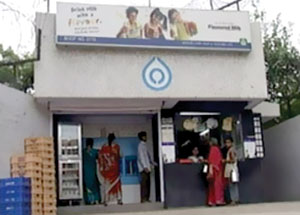 A milk depot in Mumbai. A milk depot in Mumbai.
Mumbai is poised for a milk shortage in the coming days. Suppliers across Maharashtra have prevented over 2.5 million liter of milk from entering Mumbai and Thane. They preferred instead to give it away or even throw it away.
Says a resident of Mumbai, “Milk shortage is going to hit us hard.”
“We don't even have milk for the children or to make tea,” adds another.
Says Swabhimani Shetkari Sangathan chairman Raju Shetty, “We are giving it away for free to children and villagers. We can't do business with dairies. It is not viable.”
Suppliers complain that it is economically unviable to do business with city dairies.
Some facts about milk in the market:
A liter of cow's milk fetches Rs. 18 in the retail market.
The cost of production is Rs. 14.
Suppliers only get Rs. 9 per liter.
Similarly a liter of buffalo's milk fetches Rs. 25 in the retail market while its cost of production is Rs. 18. Yet suppliers make only Rs. 12 per liter.
The city is likely to face a shortfall of 1 million liters of milk. Dairies are meanwhile making alternative arrangements to get over the crisis by sourcing the milk from Gujarat.
|Back to NEWS Diary| |TOP|
Indo-Bangla Train Service by July

The first ever train service between India and Bangladesh is expected to begin in July with the inter-country “Moitree Express” ready for operations, officials said June 30.
The train has already made several trial runs within Bangladesh with a speed of 150 km per hour after it was fitted with modern facilities, railway officials said.
Passenger carriages of the train were imported from Indonesia but they were assembled in Saidpur Railway Workshop to run between Dhaka and Kolkata, the officials were quoted as saying by the Dhaka daily Daily Star.
The engineers said the cost of each carriage varied from Taka 18 million to Taka 30 million according to the facilities available as the service comprises chair coaches of economy class, air-conditioned first class and air-conditioned sleeping class alongside a power car, one buffet car and a prayer car.
Bangladesh Railway officials earlier said there would be three categories of fares of $8, $12 and $20. Bangladesh will keep 78 per cent of the revenue while India will get the rest, as the distance between Shialdaha and the Bangladesh border is 120 kilometers while the length of the rail track in Bangladesh territory is 418 km.
A 10-coach train with the capacity of carrying a total of 760 passengers is expected to commute everyday and it would start at 7:45 a.m. from Bangladesh towards India and at 7:00 a.m. from Shialdaha to Bangladesh while it would take nearly 11 hours to reach the destinations including the time for immigration checking.
The train will run between Dhaka Cantonment rail station and Kolkata of West Bengal via Darshana without any break, officials said.
|Back to NEWS Diary| |TOP|
Air Strike Kills Over 30 Afghan Civilians
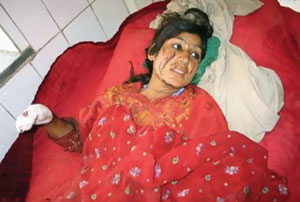 An Afghan girl injured in an air strike by foreign forces fighting the Taliban June 30. An Afghan girl injured in an air strike by foreign forces fighting the Taliban June 30.
More than 30 civilians were killed and dozens wounded June 30 in an air strike by foreign forces fighting the Taliban in Afghanistan's southern Helmand province, a regional official said.
“It happened in the early morning,” provincial official Mohammed Daoud told Reuters. “Between 30-37 civilians have been killed and tens (dozens) of others have been injured.”
A spokesman for the NATO-led International Security Assistance Force for Afghanistan confirmed the incident, but said he had heard reports that only “a small number” of civilians were involved.
U.S. Air Force Major John Thomas said that after a long skirmish and under constant fire from the Taliban, ISAF troops called for close air support during an operation in Helmand, where the Taliban has been resurgent this year.
“All enemy positions were destroyed, but after friendly forces surveyed the area, there were reports of some possible civilian deaths,” he said.
“The remains of some people who appeared to be civilians were found among enemy fighters in a trenchline,” he added.
The rising toll the conflict is taking on Afghan civilians is a sore point for Western-backed President Hamid Karzai, who is also grappling to stamp out corruption and boost the economy.
Nearly 300 civilians have been killed in operations led by foreign forces this year alone, according to government officials, residents and aid groups.
|Back to NEWS Diary| |TOP|
Relief Riots
Hungry victims of monsoon-spawned floods in southwestern Pakistan rioted, protesting slow, meager aid reaching their marooned villages where many feared the receding waters would yield numerous bodies.
Police fired tear gas and shots into the air but failed to disperse a crowd of several thousand villagers who broke into and ransacked the mayor's office in this city in southwestern Pakistan ringed by floodwaters.
The widespread flooding struck after Cyclone Yemyin dumped torrential rains on the area.
Protesters said they had waded through chest-deep water from outlying areas to voice their anger about the dearth of relief aid. Only packets of biscuits and bottles of water had been received, they said.
“Every family is looking for one or two members. They are all missing,” said Chaker Baloth, who walked more than 25 miles through the night to reach this city of some 150,000. Others feared they would never see their missing family members again.
The government said the official death toll in Baluchistan province was 14, with more than 24 missing, although local media reported much higher numbers.
Farooq Ahmed Khan, head of the National Disaster Management Authority, said accurate figures were not available because of widespread communications disruptions in the stricken areas.
Khan told reporters in Islamabad that the military had rescued about 1,600 people, including 600 fishermen in the Arabian Sea.
Military helicopters continued to drop relief supplies, but many of the more than 800,000 people hit by monsoon flooding in southwest Pakistan appeared to have received little or nothing.
|Back to NEWS Diary| |TOP|
Lanka Hopeful
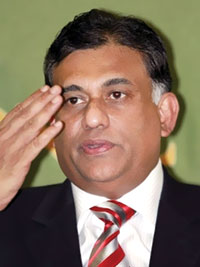 Sri Lanka Foreign Minister Rohitha Bogollagama Sri Lanka Foreign Minister Rohitha Bogollagama
Sri Lanka's Foreign Minister Rohitha Bogollagama said June 28 he was optimistic that a meeting of top donors this week would help to revive the island nation's moribund peace process.
Peace broker Norway is holding the crucial meeting of Sri Lanka's top aid donors in a bid to halt a new wave of bloodshed.
“We are expecting a very favorable development. The outcome is expected to encourage the current peace process toward contributing to the sustainability of our country,” said Bogollagama.
Oslo-brokered peace talks collapsed in October last year and since then diplomatic efforts have failed to end violence in the bitter ethnic conflict which has claimed more than 60,000 lives in the past 35 years.
More than 5,000 people have died in the latest wave of fighting since December 2005 despite a truce in place since February 2002.
Bogollagama, in Japan for the first time since he took office in January, met with his Japanese counterpart Taro Aso, who pledged about one million dollars' worth of aid for landmine removal and support for refugees.
Japan accounts for about two-thirds of total bilateral aid to the island and international human rights groups have been lobbying Tokyo to exert pressure on Colombo to stem the spiraling violence.
Bogollagama praised Japan's continued assistance even as some donor countries move to cut aid owing to alleged human rights abuses.
|Back to NEWS Diary| |TOP|
Stop Canoodling
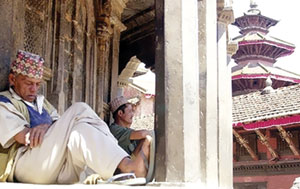 Patan Durbar square on the outskirts of Kathmandu. Patan Durbar square on the outskirts of Kathmandu.
Couples should stop cuddling and kissing near a revered square surrounded by palaces and temples in Nepal's capital because it shows a lack of respect for religion, a committee warned.
“The environment around this ancient religious site has been desecrated by these young Romeos and Juliets,” Rajan Maharjan, a supervisor from the Kathmandu Durbar Square Conservation Program Committee told AFP.
Durbar Square, a UNESCO world heritage site and popular destination for thousands of foreign backpackers to spend the day, has a series of Hindu and Buddhist shrines that date back to the sixteenth century.
But the square, which is home to a young girl revered as a living goddess and was the seat of Nepal's kings until the 1960s, has also become a popular spot for lovebirds to gather in the evening.
“Lovers kissing and cuddling while sheltering in the temples has become a common sight, so we have posted notices telling people to stop,” said Maharjan, adding that little notice has been paid to the signs.
“We put the notices up and the same day, they were ripped down, but we plan to take pictures of the couples and publish them to try and make them stop,” he said.
Nepal, where about 80 percent of the 27 million population are Hindu, is extremely socially conservative, and public displays of affection between couples are viewed as culturally unacceptable.
|Back to NEWS Diary| |TOP|
World Heritage Site
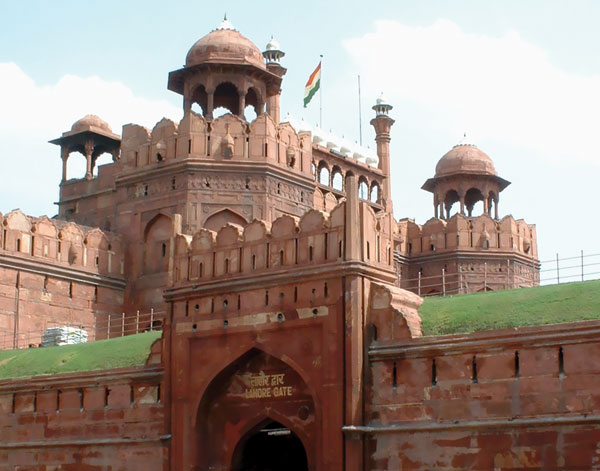
The Red Fort in New Delhi.
Delhi’s Red Fort has been declared a World Heritage Site. The announcement was made by the UNESCO's World Heritage Committee in New Zealand. Three other sites — the Sydney Opera House in Australia, the Iwami Ginzan Silver Mine in Japan and the Parthian Fortresses of Nisa in Turkmenistan — also got the coveted status.
The Archaeological Survey of India took over the fort from the Indian Army in 2003, and has since been working on a Comprehensive Conservation Management Plan for the 100-acre complex.
World Heritage status means the environs inside and immediately outside the fort need to be maintained to suit the cultural character of the monument. The ASI will be duty-bound to carry out all work. UNESCO does not always provide funding for World Heritage monuments.
There are immediate plans to revamp the Meena Bazaar inside the fort. “Our responsibility has gone up with the fort getting this international recognition. There will be zero tolerance for hawkers or encroachments. There has to be a Mughal feel inside the monument now. There are 78 shops here and the quality control will be stringent,” says an ASI official.
“This is a victory for the ASI. This is a monument that always deserved World Heritage status. Acquiring it from the Army was also a difficult task. With the Army at the helm, there was no management plan. It was the ASI which called for removing encroachments, and slowly started their restoration work. The monument has finally got its due,” says O.P. Jain from INTACH.
|Back to NEWS Diary| |TOP|
Refineries Told to Clean Up
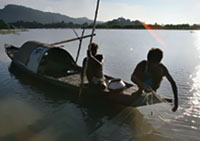 Assamese see their rivers as lifegivers. Assamese see their rivers as lifegivers.
Authorities in India's north-eastern state of Assam have threatened local oil refineries with closure unless they stopped polluting local rivers, reports the BBC.
Assam's Pollution Control Board has given five refineries a year to stop discharging effluents into rivers.
It says the refineries were dumping effluents at levels much higher than acceptable federal limits.
Two of the five refineries have told the board that they have stopped discharging effluents into rivers.
For the past two years, Assam's pollution control authorities have targeted the refineries at Digboi, Duliajan, Guwahati, Bongaigaon and Numaligarh.
They have been told to stop discharging effluents into the Brahmaputra, Bharalu, Dhansiri, Digboi, Buridihing and Tunia rivers.
Pollution control board chief Jawaharlal Dutta said the levels of discharge were 15 to 20 times higher than acceptable federal limits.
“The refineries have done huge damage to the rivers in the past 40 years. A lot of marine life, like fish, tortoises and the river dolphin, has almost disappeared,” he said.
Two of the five refineries have informed the authorities that they have cleaned up their act already.
“We have even used the treated affluent to develop a green belt in the refinery area,” the Numaligarh refinery told the authorities.
The refinery at Bongaigaon also says it has stopped discharging effluents into the river.
No independent confirmation of these claims is available from the authorities yet.
Experts say the older refineries were the main polluters, as it was difficult to install pollution control equipment in their old equipment.
|Back to NEWS Diary| |TOP|
Paraded Naked
Two Indian soldiers have been paraded naked for allegedly attempting to rape a girl in Indian-administered Kashmir, police say.
Angry residents in Kunan village near the northern town of Bandipora beat up the soldiers, stripped them bare and paraded them through the market.
Police have charged the soldiers with attempted rape.
An army spokesman said the charges were baseless, and that the villagers had been incited by “hardliners.”
Reports quoting local residents say that the two soldiers, dressed in civilian attire, forcibly entered a house in the village of Kunan.
The soldiers are said to have posed as militants and asked the family for food and shelter.
The reports said that the soldiers allegedly attempted to rape a teenage girl in the house.
When the girl raised the alarm, neighbors rushed in and joined by the family, beat up the soldiers, stripped them, shaved their heads and smeared soot on their faces, witnesses say.
The soldiers were then paraded naked through the local market by the angry mob, who also shouted slogans against the army.
Police fired tear gas shells and fired in the air to break up the demonstration before taking the soldiers into custody.
Army spokesman Colonel Manjinder Singh said that the soldiers had gone to the village to collect intelligence.
He said some “hardliners” had leveled false allegations against them, and incited the residents.
|Back to NEWS Diary| |TOP|
India Rebuffs U.S.
India has rebuffed a U.S. call to ditch the Non-Aligned Movement, saying it remains strongly committed to the 116-member organization that includes some of Washington's biggest foes.
“There can be no question of India's firm and abiding commitment to non-alignment,” Indian Foreign Ministry spokesman Navtej Sarna said in a statement.
India's declaration came after U.S. Secretary of State Condoleezza Rice called on New Delhi to “move past old ways of thinking.”
Rice told the United States-India Business Council in Washington that non-alignment may have “made sense during the Cold War when the world really was divided into rival camps” but since then it “has lost its meaning.”
The Times of India newspaper quoted un-named Indian government officials as saying the timing of Rice's comments was “particularly poor,” as India and the United States are in discussions to clinch a landmark civilian nuclear technology deal.
Some Indian critics of the deal say Washington wants to influence New Delhi's strategic policies in the talks. The newspaper cited the government officials as saying Rice's remarks would only fuel such suspicions.
The government officials also said India, one of the founding members of the Non-Aligned Movement, would never allow Washington to dictate its foreign policy.
The US, which has locked horns with Tehran over its atomic program, has already voiced strong objections to India's plans to receive gas from energy-rich Iran via a multi-billion-dollar pipeline through Pakistan.
|Back to NEWS Diary| |TOP|
Pranab Stresses Sino-Indian Ties
The India-China partnership is an important determinant for both regional as well as global peace and development, External Affairs Minister Pranab Mukherjee said in Jakarta.
Speaking on the theme of “India’s Growing Engagement with East Asia,” Mukherjee said the India-China equation was also key to Asia’s emergence as the “political and economic centre” of a new international order.
The minister, who is on his first bilateral visit to Southeast Asia, addressed a key issue of interest to the region: India’s growing engagement with China at a time when the two countries are still trying to resolve their contentious border dispute.
“As India's largest neighbor and a key emerging player in the international arena, China remains an important priority of India's foreign policy. The rapidly growing trade and economic exchanges between the two countries are pointers to the fact that India and China are now constantly engaged in mutually rewarding pursuits…” a text of his speech said.
|Back to NEWS Diary| |TOP|
|